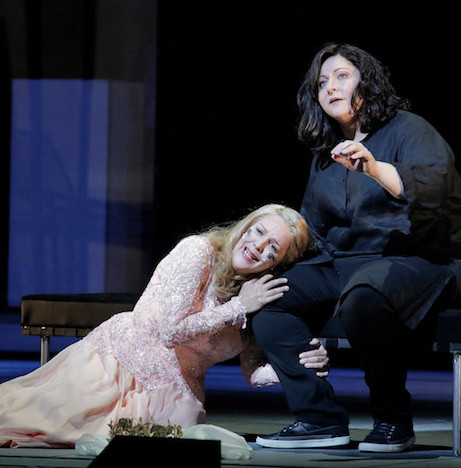
The first collaboration between composer Richard Strauss and poet Hugo von Hofmannsthal was an operatic remake of the poet’s drama, Elektra, derived from Sophocles’ tragedy of familial murder and revenge. The resulting lengthy – nearly two-hour – one-act opera is a collision of dark late German Romanticism and edgy modernism.
The opera that opened this past weekend at San Francisco Opera took all of that and stated it in contemporary terms. At the heart of its emotional success was the dramatic soprano Christine Goerke and the Opera Symphony Orchestra, thrillingly led by Henrik Nánási.
The production was set in a contemporary museum, and Goerke, dressed in black top, pants and sneakers (a costume detail she probably loved), entered the scene as a viewer intrigued by an exhibition about Sophocles tragedy. Displays of Klytemnestra’s royal dress and crown, theatrical masks and Agamemnon’s double-headed axe border the museum’s central lobby. Black-and-white video clips, with toga-clad actors in stylized Greek masks, projected from four screens. The museum closed, viewers filed from the room while Goerke hid from the guards. In the darkened museum the video clips replayed on the façade of the lobby walls, while Wo bleibt Elektra? – Where is Elektra? –was projected over the enormous, eerily masked face of a woman.
At that point Goerke, the intrusive museum-goer, becomes Elektra. As she sings about the murder of her father, the lobby doors open to reveal the scene of Agamemnon’s death. He staggers out of a steamy bath, half naked and bloody.
Throughout the opera, sections of the museum transform into domestic settings – a bedroom, a kitchen, a sitting room – each acting as a portal into Elektra’s memories. The displays also become part of the action. Klytemnestra steps from a display case, a mannequin made flesh and blood. Elektra takes the double-headed axe to give to her brother Orest, so he can murder Klytemnestra and her consort Aegisth, the dual conspirators to their father’s death. It’s all seamlessly and vividly staged. The scenic design was by Boris Kudlicka. Anja Kühnhold directed, based on the original direction by Keith Warner.
As the story continues, Elektra is confronted by a series of individuals, each with a perspective on the tragedy’s compelling murder and a need for Elektra’s attention. Her sister Chrysothemis, as injured by her father’s murder as Elektra, wants a simple, domestic life with husband and children, though she too harbors thoughts of revenge and exults in their brother’s return and Elektra’s lust for revenge. Klytemnestra wants Elektra’s love and sympathy; she approaches her daughter with the horror of her nightmares, seeking relief. These parts were sung by soprano Adrianne Pieczonka and mezzo-soprano Michaela Martens, respectively. Powerful singers both, and the three women formed a sonic constellation that was complex and nuanced, their voices rising above a multi-threaded score that was delivered by a 100-member orchestra playing 110 instruments.
Bass-baritone Alfred Walker, the returned Orest who delivers Elektra’s final revenge, is beautifully voiced, but the part is less compelling than those of the women, who reveal their interior landscapes in mesmeric detail.
The many excellent supporting singers drifted into the orchestral soundscape rather than separated as characters or even chorus, though the five maidservants had an extraordinary vocal moment at the beginning of the opera, weaving their voices as they enacted a ritual and reported on the crisis at hand.
It is Goerke though, who is onstage for the entire opera and sang through most of that time, who is truly heroic – embodying the Wagnerian – not only in her vocal endurance and theatrical power but also in her voice’s tonal richness.
And then there is Strauss’ score set to and illuminating von Hofmannsthal’s lyrics. It’s no wonder the two, composer and poet, collaborated for some 20 years after. The lyrics of Elektra often spin into Romantic excess, like this deliciously gruesome line in translation: “pavilions have been raised from the haze of blood.” Strauss uses chords for the characters that have an aural dissonance, even in harmonies, but along with those he reflects the libretto’s images of the natural world, with sections of the orchestra painting delicate but unmistakable descriptions in sound. Maestro Nánási never let the overall sound dissolve into chaos, but kept the sound compelling and precise, the music coursing dynamically.
Awesome!
– Jaime Robles
San Francisco Opera’s production of Elektra continues through September 27. For tickets and information, visit sfopera.com.
Photo: Christine Goerke as Elektra comforts Adrianne Pieczonka as Chrysthemis. Photo by Cory Weaver.
